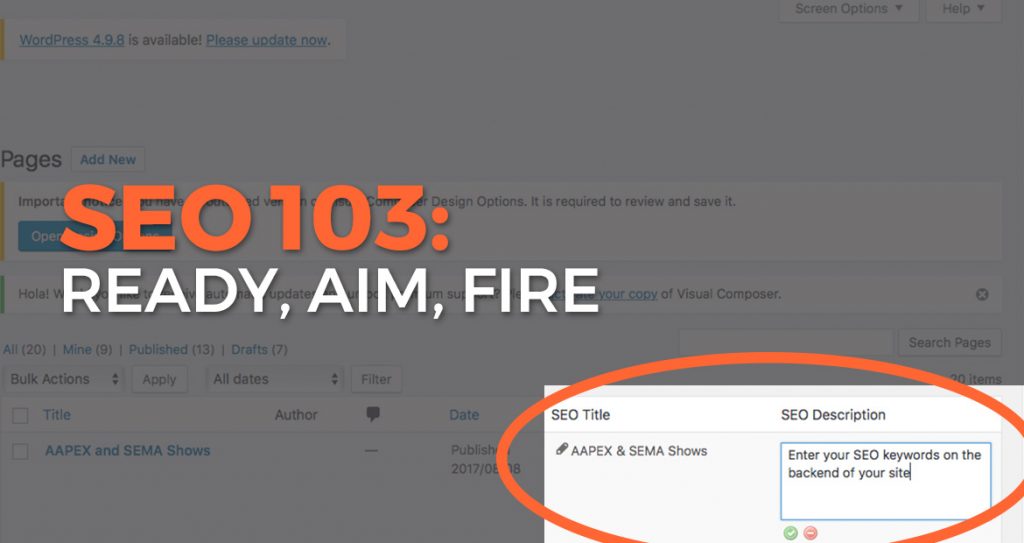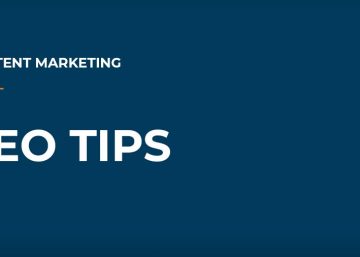SEO (search engine optimization) is a process that will always be ongoing within your website and in our first SEO article you learned where and how to start. In our second article, you took a deeper dive into your website and keywords, learning tips for conducting your own SEO audit. Now, in the final article of this three-part series, you will explore strategy that allows you to carefully map out initiatives and how to complete them, in order to reach your SEO goals.
What to include in a plan?
This plan should be tailored to your company’s needs and in support of your overall SEO goals, as previously defined by your SEO audit and any other exercises used to create your “why” for SEO.
On-site and off-site efforts are the foundation of your plan. Actionable items, due dates and who is responsible on your team for each step provide the structure, creating a living, breathing and fluid document for everyone to refer to. It can be in a written document or a spreadsheet – whatever helps you stay on track.
On-Site SEOYour on-site strategy refers to all content that lives on your website, including both the frontend and the backend.
Frontend
The purpose of SEO is to allow people to find your website based on what they type into a search engine. If you don’t have those search terms on your website, then you won’t show up in search results when those words are used. Plain and simple!
Content is key. Your website is consistently being crawled by search engines that like to see activity, so updates to the website and copy are encouraged, especially if they contain the keywords selected during your SEO audit.
Now that you understand the connection between the outward-facing frontend of your website and how it affects your ability to be found in search engine results, you can begin to infuse your website content with the most relevant keywords from your audit findings, using the steps below:
1. Benchmark. Determine the current keyword density (how many times a word is used on your site) of your website. This will give you a benchmark to work with and see how many of the desired words your website already has. Use free software like Keyword Density Checker to create a baseline.
2. Review. Look at your website flow and structure to determine if new pages are needed or if sections should be expanded so keywords can be included. However, be strategic about creating new pages – it is not just about adding content. You must think about converting your visitors – providing them with the right content will help turn them into customers, not turn them away from your website.
3. Infuse. Add your selected keywords on your current and new pages. Remember, search engine robots are smart, so make sure keywords are added appropriately. Pay special attention to your headings and subheads – having those include keywords is important, as headlines will typically rank higher than body copy in search results.
4. Refresh. Develop a content library that will continuously allow you to update your site with selected keywords. Determine what type of content can be created to utilize your keywords while engaging your targeted audience and visitors.
Examples:
- FAQs
- Blog articles
- Tech tips
- News releases
- Image galleries with captions
- Social media feeds
- Events (tradeshows, guest appearances)
- Team bios
- Product descriptions
- Case studies
- Product Reviews
Backend
Even though your website visitors do not view the backend of your website, it should not be overlooked as a crucial part of your SEO efforts. As previously mentioned, your website is constantly being crawled and scanned by search engine robots looking at your content, keywords and security, so understanding how to position your website for successful scanning to make those robots happy is key. Get started with our checklist below:
- Make sure you have a robot.txt and sitemap.xml files on your site. Each of these files provides search engine robots with instructions how to crawl and index your site.
- Title tags and meta descriptions for each page are infused with keywords and are different for each page
- Images include alt tags – this is a great spot to utilize your keywords
- URL structures are clean – no spaces (they turn into “%”) and dashes are utilized instead of underscores
- Redirects are minimal – having too many redirects lowers your SEO score
- Quick loading speed – a site that takes a long time load can increase your bounce rate
- SSL certificate installed – having a verified secure site can influence your SEO ranking
- Security features installed on your site, whether it is a plugin or provided by your hosting company
- Fix broken links promptly, both inbound and outbound
- Plug-ins are up to date
Backlinks are the backbone of offsite SEO. These are links from other websites that drive traffic to your domain. Your backlink strategy can be aggressive or more organic, all depending on your integrated marketing initiatives. Backlinks can come from a variety of places, for example:
- Social media
- Consumer reviews
- Buyer’s guides
- Directories
- Forums
- Blogs

Although some backlinks will be generated by your site simply existing, that isn’t enough on its own, so the process of building backlinks must to be done strategically. The quality of the website that is driving traffic to your website needs to be high so that it can make a positive impact on your SEO score. As you approach this piece of your implementation plan, consider a few of these tactics:
- Article writing – get your articles published in industry publications and blogs
- Ensure you have descriptions and a link to your website to all YouTube/Vimeo videos
- Participate in forums, groups, reviews or leave comments on other relevant blogs
- Utilize Google applications like Google+ and Google My Business that can make an impact on Google’s search engine
- Get your speaking engagements listed on local and industry calendars
- Get involved in the community or participate with sponsorships
Like we said, SEO is an on-going process, but by getting ready and learning the basics, aiming your efforts with an SEO audit and using an implementation plan to fire away, you have the basic tools and techniques to take your site, traffic and ultimately conversions to the next level.
Looking for more support with SEO, your website or creating a custom plan? We can help.

